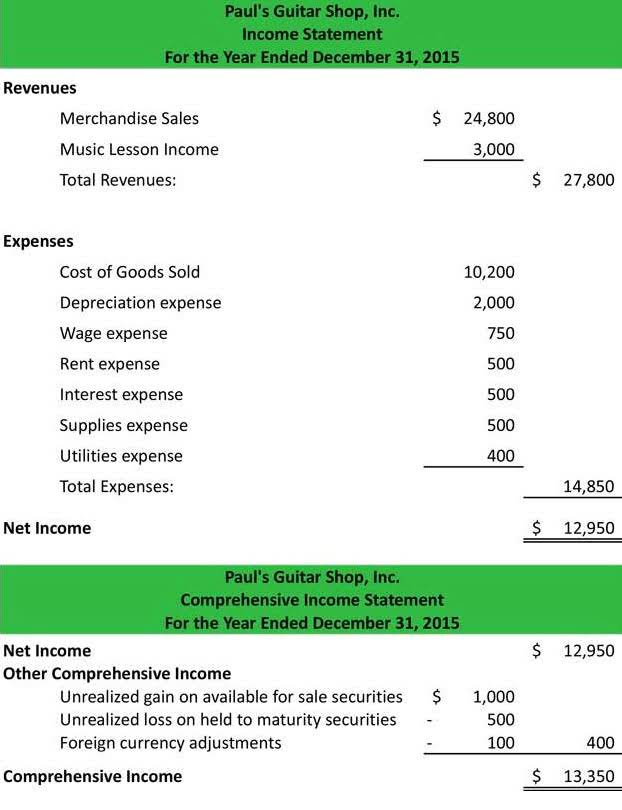manijasarroyo@gmail.com
Oriente 87, #3029, Mártires de Río Blanco, CDMX
Cash Flows from Investing Activities
Posted by Tere No hay comentarios en Cash Flows from Investing Activities Bookkeeping
Cash Flows from Investing Activities

Investors used to look into the income statement and balance sheet for clues about the company’s situation. However, over the years, investors have now also started looking at each of these statements alongside the conjunction of cash flow statements. This helps in getting the whole picture and also helps to take a much more calculated investment decision. In this section of the cash flow statement, there can be a wide range of items listed and included, so it’s important to know how investing activities are handled in accounting.
- Additionally, the impact of changes in working capital and other non-cash expenses can make it even more different.
- Assume you are the chief financial officer of T-Shirt Pros, asmall business that makes custom-printed T-shirts.
- Deducting capital expenditures from cash flow from operations gives us Free Cash Flow, which is often used to value a business in a discounted cash flow (DCF) model.
- In exams, students are often asked to classify transactions, prepare, or analyze cash flow statements.
- Cash flows from operating activities arise from the activities a business uses to produce net income.
- These activities—operating, investing, and financing—each play distinct roles in shaping an organization’s financial statements and overall strategy.
How are gains or losses from asset disposal reported?
Investments in stocks, bonds, or other financial instruments are also considered investing activities. For example, if your company invests in shares of another company or buys government bonds, these transactions would be classified as investing activities. Earlier, we discussed how the cash from operating activities can use either the direct or indirect method. Most companies report using the indirect method, although some will use the direct method (see CVS’s 2022 annual report here). The items in the operating cash flow section are not all actual cash flows but include non-cash items and other adjustments to reconcile profit with cash flow.
What is the difference between an indirect and a direct cash flow statement
The choice between short-term and long-term debt affects financial leverage and borrowing costs. Cash spent (cash outflow) means that the investing activity cash flow was negative. However, the sale of investments (cash inflow) means that the investing activity cash flow was positive.
- When business takes on debt, it does so by taking a loan from the bank or issuing a bond.
- Lastly, the net cash flow from investing activities, when channeled towards CSR and sustainable projects, can shape the financial character of the firm.
- A reduction, on the other hand, signifies that the asset has been sold during the period.
- In accounting, investing activities encompass transactions related to the acquisition and disposal of long-term assets like property, plant, and equipment (PP&E), and investments in other companies’ securities.
- These capital expenditures appear in the cash flow statement and highlight a company’s investment priorities.
- Common examples include the purchase of property, plant, and equipment, which is essential for a company’s operational capabilities, and the acquisition of financial investments, such as stocks and bonds.
Extracting Insights from Investment Activities

Another interesting aspect to look into this CFI is the column of proceeds from the disposal of fixed assets and proceeds from the disposal of a business. If the figures are substantially high, it can help visualize why https://cagdf.net/free-online-fifo-and-lifo-calculator the company is disposing of assets. As we already know that CFI is related to non-current asset portions of the balance sheet. There are two main items in non-current assets – Land and Property, Plant and Equipment. Cash Equivalents are short-term highly liquid investments that can be easily converted into a known amount of cash with insignificant risk. Cash and Cash Equivalents also consist of investments that have a maturity period of three months or less from the date of acquisition.

This noncash investing and financing transaction was inadvertently included investing activity accounting in both the financing section as a source of cash, and the investing section as a use of cash. IFRSs, however, require such cash flows to be reported on a consistent basis from period to period. When a medium other than cash is used to acquire an asset, we call it a non-cash investing activity. When we prepare a statement of cash flows, we are concerned only with cash transactions. The significant non-cash investing activities are, however, disclosed in the footnotes under the caption “non-cash investing and financing activities”.

2: Differentiate between Operating, Investing, and Financing Activities
These activities reflect the company’s priorities and vision for expansion, and they can significantly influence market positioning. Investing activities are vital for financial analysis because they provide insight into how a company is planning for its future growth and sustainability. By examining these activities, analysts can gauge a company’s commitment to investing in new projects, technologies, or assets that may enhance its competitive position in the market. This information can also indicate whether the company is expanding or consolidating its operations. Following are some of the examples of positive and negative cash flow statements. Investing activities comprise the second section of the cash flow statement where it is representing the cash inflow and outflow of the business.

What is Cash Flow from Investing Activities?
Each of these transactions can signify a company’s efforts to expand its footprint, diversify its asset base, or enhance its overall financial health. Understanding these activities is crucial for stakeholders evaluating both current and future value generation potential. Furthermore, analyzing the cash flows from investing activities allows stakeholders to assess the effectiveness of a company’s investment strategy. Positive cash flows indicate that a company is successfully turning investments into profitable ventures, while negative cash flows may suggest that QuickBooks ProAdvisor investments are not yielding the desired results. Understanding these dynamics can help investors make informed decisions about their stakes in the company.

It usually involves the sale and purchase of long-term investments in debt and equity instruments of other entities. Examples of debt instruments (also known as debt securities) are government bonds, corporate bonds, mortgages, etc. The holder of such instruments is generally entitled to receive periodic interest income at some specified rate. Equity instruments (also known as equity securities) are the stocks of other companies that entitle the holder to receive dividend income. A company’s financial health is often assessed by its profitability, but understanding how it manages its cash is equally important. The Statement of Cash Flows provides a comprehensive picture of all cash inflows and outflows within a specific period.
busca lo que necesites
Envíanos un Whatsapp
![]() 55 37 02 43 92
55 37 02 43 92
Tus Compras
Categorías
- ! Без рубрики
- 1
- 10bez10.com
- 1k
- 1w
- 1Win AZ Casino
- 1WIN Casino Brasil
- 1WIN Official In Russia
- 1win Turkiye
- 1win-oyna
- 1win-uz-kirish.org
- 1winRussia
- 1x
- 1xbet apk
- 1xbet Argentina
- 1xbet Azerbajan
- 1xbet Azerbaydjan
- 1xbet Brazil
- 1xbet giriş
- 1xbet Kazahstan
- 1xbet-azerbaycan
- 1xbet-india-online.in3
- 1xbet-kirish.com
- 20Betslovenia.com
- 22bet Schweiz
- 437
- 616
- 8xbet Online 898
- aarhusaffairs.dk
- abukingcasinofrance.com
- adaptationfestival.gr
- adonnasbakery.net
- Aerobetcasino.net
- Ai News
- Ai News 2025
- akss.uz
- alexandercasinofrance.net
- Allyspin-casino.net
- Allyspinkasyno.pl
- almaradio.gr
- Almarokna
- Almissa.org
- amnistiepdm.org – Official Website of Safe Casino Sites in South Korea
- Amunracasino-si.com
- Amunracasino.info
- anbhoth.ie
- answers
- apple-of-fortune.org
- archpoints.gr
- articolo
- artt.hr 2
- asian brides
- asian mail order brides
- asian-culture-festival.dk
- Asino.casino
- Asinoonline.com
- ateliermasomi.com
- aviamasters-games.net
- Aviator
- aviatorgame.org.uk
- aviatorgamedownloadapk.org
- AZ Most BET
- Azerbajany Mostbet
- aztecfireslot.us
- b1bet apostas
- Bahis sitesi
- Bahsegel
- BC Game Casino
- bcgamedownloadandroid.com
- bdmbetitalia.com
- bedpage
- belanok.mk
- Beritabawean.com
- best asian dating sites
- Best Countries To Meet A Wife
- Best Country To Find A Wife
- best dating reviews
- best dating sites
- best dating sites for over 40
- best dating websites reviews
- best mail order bride sites
- best mail order brides sites
- Best Mail Order Brides Websites
- Best Nationality Man To Datehttps://3.bp.blogspot.com/-kBknlnppsDo/VogAaAUQObI/AAAAAAAAGIQ/GwgzMkHTbi4/s400/beautiful-bbw-13_mini.jpg|loving someone long distance
- Best rated casino
- Best Reviewed Dating Sites
- best senior interracial dating sites
- Bet365 Official Global website
- Bet365 Schweiz Website
- Beticocasino.net
- betonred-australia.net
- betonred-cz.org
- betonreddeutschland.com
- betonredespana.net
- betonredfrance.com
- betonredpl.win
- betonredportugal.net
- betsafecasino.uk
- Bettilt
- Bettiltportugal.live
- bht2
- bigbassbonanza.cc
- bigbasssplash.cc
- bigbasssplash.com.es
- Bigclash-canada.com
- billionairespinespana.com
- billionairespinit.com
- bistro-one.ie Casino Friday
- bizzo.at
- blog
- blog en ligne
- bobosummercup.it
- Bookkeeping
- Boomerang-si.com
- Boomerangcasino.info
- Bootcamp de programación
- borka.org.mk
- Bravodate
- brides
- bridgestl.org
- btt2
- bukmacherzy legalni
- Buy Semaglutide
- Can You Really Mail Order A Bride
- candyspinzespana.com
- candyspinzfrance.com
- carlosserrano.org
- Carpentry
- casadonramon.com.mx
- cascbar.co.uk
- cashwindeutschland.com
- cashwinosterreich.com
- casino
- Casino games
- Casino slots
- Casinoandyou-casino.com
- Casinoandyou.pro
- Casinocaspero.com
- casinoinfinityespana.com
- casinonic.us
- casinonicaustralia.net
- Casinos Online con pesos chilenos
- catholicmyanmar.org
- cc-women-hellas-virtual-events.gr
- cdu-ruegen.de
- CH
- Chatbot News
- Chatbots News
- Chathub
- Chatib
- chicken-cross.org
- chicken-road-game.org.uk
- chicken-road-it.org
- chicken-road-online.net
- chicken-road2.co.uk
- chickengamegambling.net
- chickengamegambling.us
- chickenroadgame.cc
- chinese women dating
- chiorc.gr
- CIB
- ciispecialabilityjobs.in
- Cities
- Cleobetra-casino.pro
- clovermagic.us
- clovermagiccasino.us
- Cocoa Casino
- Codere Argentina
- Codere Italy
- Construction
- Counter Strike 2
- crazy-time.cc
- Creativity
- cresus-casino.us
- crossyroadgambling.co.uk
- crownplaygreece.com
- Crypto News
- Cryptocurrency exchange
- CS:GO
- CS:GO Betting
- cultura.cosenza.it
- czbrandss
- czdrops25monobrands
- dating
- Dating Foreign Women
- dating online
- dating over 40
- Dating Tips
- definemystyle.com
- Divaspin-casino.com
- Divaspincasino.org
- dobravina.hr
- Dollycasino.live
- Dota 2
- Dota 2 Betting
- Dragonia-hungary.com
- Dragonslotscasino.org
- Dragonslotscasino.pl
- drivein.hr
- drop sk, cz
- duckhuntersslot.us
- dutchbikeshop.ie Casinoly
- eastern european wives
- EC
- Echat
- Ecomretix.com
- Education
- ehealthsummit.at
- erome
- es-es
- esc-privaterooms.de
- Esport
- ethnicitycelebration.ie MyStake
- eyeofhorus.cc
- fadoinabox.pt
- Fair play casino
- Fairspin-casino
- Fairspin-hu.net
- Fairspincasino.games
- Fezbet.live
- filipino brides
- find a bride
- FinTech
- Fleksion.com
- fond.hr 2
- Forex education
- Forex News
- Forex Trading
- Fqdns.net
- fr-fr
- Fridayroll-casino.net
- Fridayroll.pro
- fufrogslot.com
- funkyaardvark.co.uk
- Gambloriacasino.net
- Game Emulator Roms For Android
- garden2table
- gatesofolympus1000.com.de
- gatesofolympusslot.cc
- gay
- generated_texts
- geratalentos.pt
- gerbera.cc
- gg bet
- godsgypsy.com
- gopbeavercounty.org
- gradzasite.mk
- Guerradelpacifico.org
- gxmble.uk
- hkresources.org
- Hot News
- hot women
- hothotfruit.net
- Hotslotscasino.net
- Hotslotscasino.org
- hotslotspl.net
- how to find a wife
- hqporner
- hrcarers.org.uk
- hudsunmedia.com
- Hugo.casino
- Icecasino-portugal.com
- Ilifewire.com
- ilk.ie PalmSlots
- ilpedante.org
- imvest.it
- India Mostbet
- informscotland.uk
- inovirajprofitiraj.hr
- Internet Bride
- interracial dating
- Interwetten Casino Schweiz
- Interwetten Österreich – Offizielle Website
- Interwetten Schweiz
- investacadiana.org
- irelandskillslive.ie Rolletto
- Irwin-pt.com
- iskonstrukcije.hr
- IT Vacancies
- IT Образование
- ivermectin
- ivibetcasino-hu.com
- Jackpot slots
- jamesbrausch.com
- japan-greece-business.gr
- japanese mail order brides
- japanese mail order wives
- japanese wife finder
- japanese women
- JetX
- JetX Game
- Jodah.org
- jonbet.br.com
- Joomy.net
- jpbrewery.com
- Kaloxdigital.com
- kampo-view.com
- karaokemelody.com
- kasyno
- keepaneye.mk
- khl.hr 2
- kingmakercasinofrance.com
- komikerklubben.se
- kungsformedling.se
- lalabetnederland.net
- latin brides
- latin dating sites reviews
- latin mail order wives
- legacyofdeaddemo.com.de
- legit brides
- Lemoncasino.net
- lemoncasino.us
- Lemonkaszino.net
- LeoVegas Finland
- LeoVegas India
- LeoVegas Irland
- LeoVegas Sweden
- leovegasespana.com
- leovegasosterreich.com
- lepharaoh.co.uk
- lepharaohslot.co.uk
- Licensed online casino
- Linkayz.com
- list crawler orlando
- listcrawler corpus christi
- Local News
- locandadelcolonnello.it
- lokalenizbor.mk
- LuckyJet
- luckymister.us
- Mad-casinos.com
- Magiuscasino.co
- mail order bride
- mail order bride usa
- Mail Order Bride Websites
- mail order brides
- mail order wives
- Mailorder Brides Cost
- marniegrundman.com
- mass-greisslerei.at
- mayorjaney.com
- meet filipino girls
- meet women online
- megajokernetent.com
- megajokerslot.net
- Mericola.com
- Minebitcasino.com
- missionuncrossable.co.uk
- mladihr.hr 2
- Mobile casino games
- mobileporngames
- Monkeytiltcasino.net
- monsterslots.uk
- mostbet apk
- Mostbet Az 218
- mostbet az 90
- Mostbet AZ Casino
- mostbet azerbaijan
- Mostbet Casino 697
- Mostbet Casino Azerbaycan
- mostbet giriş
- Mostbet India
- mostbet kirish
- mostbet ozbekistonda
- mostbet royxatga olish
- MostBet Schweiz Website
- mostbet tr
- mostbet uz
- Mostbet UZ Kirish
- mostbet-azerbaycan-giris
- mostbet-oyna
- mostbet-ru-serg
- mrmenshow.com
- nappstarrocks.com
- naturegeek.me
- Neospin.vip
- New
- New online casinos
- news
- Nine
- Nine9casino.net
- Ninecasinoonline.net
- NLP software
- nppr.hr
- NV Casino Schweiz Bewertungen auf TrustPilot
- nvcasinonederland.com
- nzhoops.co.nz
- Oceanspin.pro
- Oceanspincasino.org
- oddboy.nz
- Official rating of licensed and safe online casinos in South Korea
- Offizielle Interwetten-Website
- offizielle Website 22bet
- Omegle
- Omegle cc
- omegle.is
- onlifezone.com – 대한민국의 라이선스 카지노 사이트 평가를 제공하는 국가도박관리위원회(NGCC)의 공식 정부 웹사이트입니다
- Online casino slots
- online dating sites
- Online Kasina
- organismosathinas.gr
- pagbet brazil
- parcadfer.com
- Paribahis
- PariMatch India
- parteineueliberale.de
- Pasino Schweiz
- pauzazapregled.mk
- Payday Loans
- pbt2
- penaltyshootoutespana.com
- penaltyshootoutitalia.com
- petzanet.hr
- petzanet.hr 2
- Pin Up Brazil
- pin up casino
- Pin UP Casino AZ
- PinUp apk
- Pistolocanada.com
- Plan-bet.pl
- Planbet-bangladesh.net
- Planbet-bd.org
- Planbet-de.com
- Planbet-pl.com
- Planbet-poland.pl
- Planbet.casino
- Planbet.cc
- Planbet.global
- Planbet.info
- Planbetbangladesh.com
- Planbetbangladesh.net
- Planbetpartner.net
- Planbetpolska.pl
- planet9.hr 2
- Plangames-germany.com
- Plangames.io
- Playfinacasinoaus.com
- playojo.games
- playregal.co.uk
- playregalfrance.net
- playuzu.games
- plinko-official.com
- plinkoerfahrung.org
- plinkogamecasino.net
- plinkorecensioni.org
- poduzetnicki-centar.hr 2
- Pokemon Emerald Free Downloads
- Polish Betting Sites
- polish mail order wives
- porndude
- porngames
- Post
- Posts
- radio-krapina.hr
- ragingrhino.org
- rainbowriches.cc
- ready_text
- Real Mail Order Bride Sites
- Real money slots
- Referencement-net.org
- ricordiamocidellinfanzia.it
- rioacegreece.com
- rippercasinoaustralia.net
- rjlprecisioneng.co.uk
- robocathungary.com
- Rockyspin-casino.com
- Roku bet
- Rokubetportugal.com
- roll-x-game.net
- Roobet Schweiz
- roobetchickengame.co.uk
- Rootzcasino.com
- Royalreelscasinoaus.net
- royalvegasnz.net
- russian brides
- russian mail order bride
- russian wife finder
- rybelsus
- Safety
- sajtnagodinata.mk
- seanamoni.gr
- selahaudio
- Semaglutide
- Semaglutide Online
- seokaya-in-telegram
- setembroavidainteira.pt
- sex chat
- Single Women For Marriage
- singles dating sites
- skipthegames
- Skokka
- slot
- Slotlounge.pro
- Slotloungecasino.com
- Slots online
- slots-magic.us
- Slotsgemcasino.pl
- Slotsgemkasyno.com
- Sober living
- socialgroundscc.com
- societaoffshore.org
- Software development
- space-interiors.it
- spain
- spankbang
- Spartacasino.net
- spin-genie-casino.uk
- spin-madness.net
- spinangacz.com
- spinangaespana.net
- spinangaportugal.net
- Spinbara-greece.com
- Spinbarakasino.com
- Spinline-greece.com
- Spinline-hungary.com
- Spinline.casino
- Spinline.club
- Spinline.org
- Spinline.vip
- Spinlineaspain.com
- Spinlinekaszino.com
- spinmama-de.com.de
- spinmama-pt.com
- spinmamaespana.com
- spinmamafrance.net
- spinmamaitaly.net
- Sshttc.org
- star-casino.us
- starcasinocz.net
- starcasinodeutschland.com
- starcasinoitalia.com
- Stardacasino.live
- Start today
- staybler.com
- stockx.co.nz
- Stone-vegas.com
- Stone-vegas.live
- Stonevegas.cloud
- Stonevegascasino.com
- sugar dating
- sugar dating review
- sunfilos.gr
- sunofegypt3.uk
- superacedemo.net
- surfoutportugal.pt
- sweet-bonanza-germany.com
- sweetbonanzaargentina.com
- sweetbonanzaslot.us
- tandemngo.gr
- tedxmarseille.com
- teleia.com.gr
- test
- test 2 18.07
- tfsvl.co.uk
- thai women
- the-omegle
- thegoodjerky.com
- Thepokiescasino.org
- tkokaze.hr
- top dating sites
- top dating sites reviews
- Top online casinos
- Trusted casino sites
- Tsarscasino.live
- Twenty20.bet
- twiceastranger.net
- twinspin.co.uk
- Ucategorized
- Uncategorized
- Uncategorized1
- uniquecasino.us
- unpolitical.gr
- UsaSexGuide
- UZ Most bet
- Vavada Casino Schweiz
- Vemapostarcasino.com
- Verdecasinopt.com
- very-well-casino.org.uk
- Vicibetcasino.org
- vietnamese brides
- vincispin-pt.net
- Vincispinkasyno.pl
- voziodsrce.mk
- vozivo.mk
- vulkan vegas DE
- vulkan vegas DE login
- Vulkanvegascasino.live
- wanteddeadorawildslot.us
- Wazamba-si.com
- Wazambakasyno.com
- wbcommunitytrust.co.uk
- wbcommunitytrust.co.uk2
- wearerritual.com
- Wettigo Suisse – agenceapocope.com
- What Are Russian Women Like
- Wheelonroad.net
- Where To Find Single Women
- wife finder
- wild-bandito.net
- wildbanditodemo.org
- wildrobincasino-de.com
- Winmega.info
- winvegasplus.org
- wonacofrance.com
- woodyshotdogs.com
- xnxx
- xristianodimokrates.gr
- xvideos
- yayas.uk
- Zodiaccasinoslovenia.com
- zoosk
- казино
- Криптовалюты
- Новости
- Новости Форекс
- Обновления
- ПАрущуки
- Финтех
- Форекс брокеры
- Форекс обучение
- Форекс партнерская программа
- 카지노사이트 – onlifezone.com
- 카지노사이트 순위 한국에서 가장 인기있는 온라인 도박 플랫폼
- 카지노사이트추천
- 한국 안전 카지노 사이트 평가
- 한국 정부 승인 최고 안전 카지노 순위는 onlifezone.com 에서만 확인 가능합니다
- 한국에서 허가받고 안전한 온라인 카지노의 공식 등급 – onlifezone.com
Recent Posts
1win букмекерская контора вход.3946
Проверка сертифицированных слотов в гэмблинговом клубе
Archives
Tags
Do you have any questions?
Contact us at the The Roof WP office nearest to you or submit a business inquiry online
Contact Us


 Envíanos un whatsapp
Envíanos un whatsapp